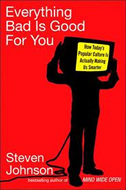
Title: Everything Bad is Good for You
Author: Steven Johnson
Source: Veddma library
ISBN: 1-57322-307-7
Available online
Notes: This book undermines the “well-known fact” that pop culture is getting dumber with time. It does not address the content, but rather the work a human mind has to perform to follow a modern videogame, film, or TV series. And the claim is that the pop culture films and TV shows of today are much more complex than those of yesteryear.
The author introduces the notion of the Sleeper Curve: the notion that “the culture is getting more intellectually demanding, not less”. He notes that usually it is the content, the message, the morale of the story that gets analyzed, causing mass culture to be labelled as dumb, catering to “low instints”, and providing masses with simple pleasures. He does not dispute that point. He instead is interested in how evolving technology, economic reality, and neurological “appetites” of the brain form the mass culture as it is.
Playing a game like GTA or Sim City, he claims, requires a lot more skill, attention, and patience (as opposed to the “instant reward” that outsiders to the game culture associate with playing videogames) than games like Pac-Man did. Specifically the skills of probing (testing the limits of the gaming environment and its rules) and telescoping (such as performing task C in order to get an item to perform task B in order to get access to task A) are important to the gamer’s success all the more with the latest games. The author mentions that saying that videogames improve hand-eye coordination is equivalent that saying that books improve spelling skills. While being correct, these statements only mention one, not the most significant, effect of the particular medium.
Watching TV shows like 24 or The Sopranos and following the social network of the characters involved requires a lot more concentration than following a Dragnet episode. The number of plot lines has also significantly increased over time, whereas the number of “flashing arrows” (hints that identify the important events or people) has decreased. It takes mental effort not only to follow the show while watching an episode, but to construct the social network and the show’s reality afterwards, connecting people, events, motivations, and consequences.
Least Objectionable Programming (during the days of the 3 television networks), targeted at not losing the audience to another less-objectionable program, has been replaced with Most Repeatable Programming, which is achieved by layering the complex meanings, conversation, events, or timelines, aimed at repeated watching of the episode or film. The latter is more important in the age where premieres have given their primary importance to re-runs and releases on DVD. This gives an economic reason to make the shows more complex.
The Internet and computer use introduce the need for the mental ability to probe once more – whether it is learning how to use a new application without a manual, picking things up as you go, multi-tasking, using various means of communication, tracking online social networks, and so on. Analysis of complicated plot lines of TV shows spills over to the fan sites where motivations are analyzed and discussed, episode guides are created, and arguments are carried out. The videogame world is amended with Internet fan sites, chat groups, LAN servers, and walkthroughs. All this usage of various media and connections between them require significant mental efforts, – something that people 30-40 years ago did not need to be entertained by mass culture.
Films are not comparatively as innovative as the TV shows can be, mostly due to the constraints of time: a film only has a time equivalent to a TV series pilot to introduce all the characters and circumstances and bring the plot lines to a logical conclusion. However, some films do push the limits. The author mentions “Magnolia”, “Eternal Sunshine of the Spotless Mind” and a few others, as films whose experimental nature would probably not make them as popular 30-40 years ago as they are today.
The first part of the book describes the different media and discusses the changes happening over time. The second part presents research to support the author’s claim. He talks about the IQ measurements that have steadily risen for the middle range, while test scores have not. All the shortcomings of IQ as a measure of intellect put aside (the author chooses this measure primarily due to presence of the related data), the claim is that the rising complexity of the mass culture is responsible for the rise in IQ level.
He also discusses various videogame-related studies, as well as TV show’s social network mappings and plot line graphs. The author concludes by saying that even though the videogames and TV shows do train the mind to be more effective in pattern recognition, it does not imply that reading or spending time outside is less important. Each activity has its own merits, and it is a matter of combination of a wide range of activities to promote the intellectual development.
I quite liked the book for the less opinionated and more scientifically-based discussion. The author certainly has done his homework to outline and strengthen his claims. It would be great if the book had a better organized structure than several very large run-on-forever chapters.





